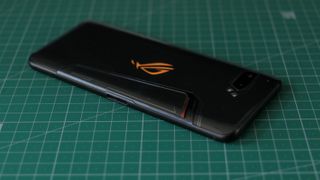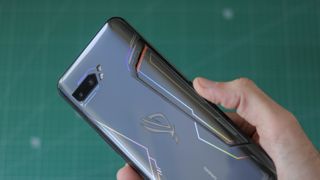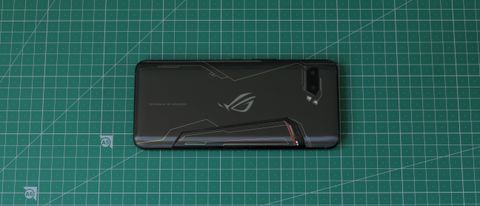Why you can trust TechRadar
Battery life
- 6,000mAh capacity lasts up to two days
- 30W Quick Charge 4 charger included
- Battery optimizations within settings
With 6,000mAh of battery inside, even the massive power demands of a huge 120Hz screen don’t stop the ROG Phone 2 from impressing. It lasts a full day without breaking a sweat on auto-brightness, and if you’re careful it can get you through two - just make sure the gaming-centric X Mode and the phone's RGB lighting are turned off.
Within the settings, there’s a PowerMaster feature that opens up control over apps that auto-start, giving you access to a range of battery modes, including Power Saver, Super Saver, and Battery Care, as found in Sony Xperia phones, which slows down charging time to preserve the longevity of the ROG Phone 2’s battery during its entire life.
Turn it off, and thanks to the 30W Quick Charge 4 HyperCharger that ships with the phone, you’ll get about 40% of battery in about 30 minutes, which is impressive given the sheer size of the cell inside the ROG Phone 2. Note however that there's no wireless charging.

As for screen-on time, after 90 minutes of full brightness HD video playback at 120Hz, the battery dropped by 8%, and with battery savings to be had by dropping the screen refresh rate, the ROG Phone 2 climbs to the top of our battery leaderboard.
Camera
- 48MP and 13MP rear lenses
- 24MP selfie camera
- Camera is good rather than great
On paper, the camera is definitely the ROG Phone 2’s least impressive feature. While most flagships (and mid-rangers) have at least three cameras, this gaming phone features two, shirking the telephoto module that gets you closer to the action.
Its main sensor is the 48MP Sony IMX586, also seen on the Honor 20 Pro and OnePlus 7 Pro. The other camera is a 13MP ultra-wide, which also uses a Sony sensor.
The Asus ROG Phone 2 lets you shoot virtually any scene in good light and you’ll almost always get a decent photo out of it despite the phone’s lack of optical image stabilization (OIS). HDR+ processing also kicks in to avoid blown-out highlights and too many dark-looking areas.

Even without using the dedicated night mode, you can expect low-light images that appear brighter and clearer than they seem to the naked eye, with fair sharpness and solid detail. Night mode really helps with the edges of the shot, which can tint purple in dark scenes when shooting in auto.
The Asus ROG Phone 2’s secondary wide camera doesn't perform quite as well at night. Some fuzziness crops up when you pinch in. Having said that, unlike some phones, you can use the phone’s night mode with the ultra-wide camera too, which nicely brightens things up.
If you want a bit more detail from your shots, and the lighting is perfect, you can change the default shooting resolution from 12MP to 48MP. This deactivates auto-HDR, and noticeably degrades quality in challenging scenes, but also gives you a picture you can crop into more readily if the light is on your side.

With a Pro mode that gives you scope to keep the shutter open for up to 32 seconds, even if the automated modes don’t give enthusiasts exactly what they’re after, there's plenty of manual control available.
Video is shot at a maximum resolution of 4K at 60fps, and despite the lack of OIS, electronic image stabilization clearly kicks in across frame rates unlike some phones like the Xiaomi Mi 9 SE, which cap out when you hit 4K resolution at 30fps.
Video quality is impressive from the main camera across lighting conditions, though dark areas do flare up with some color noise. The wide camera, though, performs less favorably. Meanwhile, slow-motion capture caps out at 240fps at Full HD and 480fps at 720p.
The front camera captures selfies at 24MP or video at Full HD 60fps. While there's no autofocus, it still captures clear photos and videos, and image stabilization is solid, though it does have a narrow field of view compared to most selfie cameras - likely optimized for landscape in-game live streaming.
Camera samples






Current page: Battery life and camera
Prev Page Introduction, design and display Next Page Anything else I should know?Basil Kronfli is the Head of content at Make Honey and freelance technology journalist. He is an experienced writer and producer and is skilled in video production, and runs the technology YouTube channel TechEdit.

Vodafone wants to help UK SMBs get more productive than ever before

Nikon Z 40mm f/2 review: this cheap, modern 'nifty forty' has been my every day lens for over a year and it hasn't let me down

Could ChatGPT be the next big cybersecurity worry — researchers say it can crack systems faster than ever before

